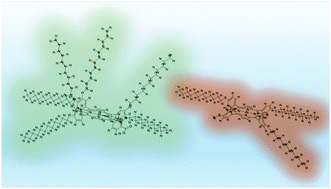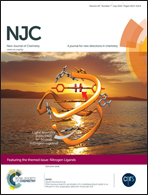Two new bulky substituted Zn porphyrins bearing carboxylate anchoring groups as promising dyes for DSSCs†
Abstract
Two novel zinc-metallated porphyrins (ZnP3C and ZnP6C), bearing three and six long alkoxy chains at the periphery of each porphyrin and a terminal carboxylic acid group, have been synthesized and fully characterized. Photophysical and electrochemical measurements demonstrated that the two sensitizers possess suitable frontier orbital energy levels for their use as sensitizers in DSSCs. The solar cells sensitized by ZnP3C and ZnP6C were fabricated resulting in power conversion efficiencies (PCEs) of 5.03 and 6.09%, respectively. As shown by photovoltaic measurements (J–V curves) and incident photon-to-current conversion efficiency (IPCE) spectra of the two solar cells, the higher PCE value of the latter is attributed to its enhanced photovoltaic parameters, and particularly its enhanced short circuit current (Jsc). This is related to the stronger absorption profile of the sensitizing dye ZnP6C and the higher dye loading of the corresponding solar cell. Furthermore, electrochemical impedance spectroscopy (EIS) showed that the DSSC based on ZnP6C exhibits a longer electron lifetime (τe) and more effective charge recombination resistance between the injected electrons and the electrolyte.

- This article is part of the themed collection: Nitrogen Ligands

 Please wait while we load your content...
Please wait while we load your content...